Other services: Planetmap | Junocam | Jovian impacts | Venus BepiColombo Flyby
The European-Japanese joint mission BepiColombo (ESA/JAXA) will arrive to Mercury on December 2025 after an interplanetary trajectory in which it will perform two flybys of Venus on 15 October 2020 (03:58 UT, the exact time may vary) and 10 August 2021. The flybys will be a unique opportunity to study Venus from a multiple perspective. During the flybys BepiColombo will obtain observations of Venus in coordination with the Japanese Akatsuki mission (JAXA), currently in an equatorial orbit around the planet. In addition, a large ground-based campaign to observe Venus has been organized not only during the flyby, but also in August 2020, when Venus reaches its maximum elongation (45 deg), with an apparent size from Earth of 23-24 arcsec.
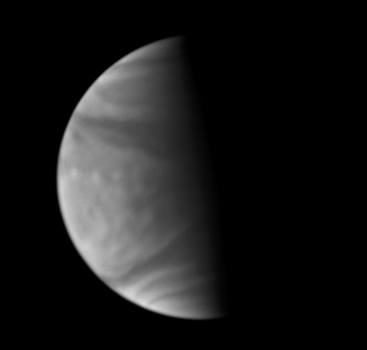
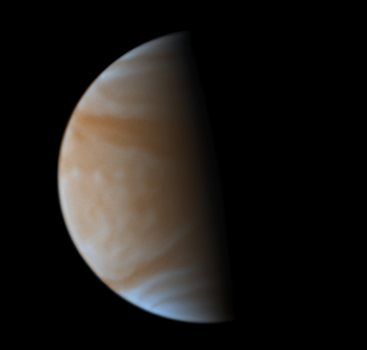
We are seeking context observations of Venus provided by amateur astronomers to enhance the scientific return of the BepiColombo flyby in October 15, 2020. To that end, we encourage amateur observers to observe Venus in mid-July, late August and mid-October 2020. Observations around 11 July 2020 will be used to support the analysis of data acquired during the 3rd flyby of Venus by the Parker Solar Probe (NASA) on 11 July 2020.
Images on the right show Venus observed from the Pic du Midi 1.05m telescope by a group of amateur astronomers in 2017 and processed by D. Peach. Observations obtained also in smaller telescopes with similar techniques (fast cameras) have a high potential to study the atmospheric activity visible in Venus clouds.
SCIENCE OUTCOME
We expect that observations provided by a large group of collaborators from different locations on Earth will be able to cover Venus atmosphere and study its atmospheric superrotation as it was done prior to the Akatsuki orbit insertion in 2015 (Sanchez-Lavega et al. ApJL, 2016). Amateur observations of Venus in 2007 were also analyzed in the context of the MESSENGER flyby ( Peralta et al. GRL, 2017). A recent study combining observations obtained by the Akatsuki mission, professional telescopes and observations provided by amateur astronomers was published recently and shows the value of amateur images in combination with spacecraft data (Peralta et al. GRL, 2019).
Observations of Venus surface are also welcome. We expect that the large number of observations obtained by
different teams around the BepiColombo flyby in combination with the ground-based amateur campaign will produce a unique
set of observations of Venus. Initial results from the August 2020 observations will be presented at the
EPSC2020 conference.
Observation windows of Venus are discussed in this publication:
Amateur observations in the following windows are desired:
Cloud contrast is strongest in UV, strong in Vio, very weak in blue, and weak (but with real feature)
in wavelengths above 700 nm. The contrast in RGB images of the Venus' clouds is extremely low. However,
on occasion, images taken with a green filter have proved useful in the study of intermediate clouds.
Examples of observations in these wavelengths are given in the figure on the right composed from observations available in the PVOL database
and acquired by T. Olivetti, N. MacNeill, M. Kardasis and M. Lewis. The images have been edited for the purpose of fitting them in a single figure.
Lower clouds: Some observers may have access to cameras operating at wavelengths beyond 1.0 microns. These cameras can also observe the lower clouds
of Venus through the infrared radiation that escapes from the planet through holes of lower cloud content at an altitude of about 50 km above the surface.
The image of the right was kindly sent by Dr. Sebastian Voltmer and
is a demonstration of this capability using a Ninox 640 II SWIR camera from Raptor Photonics and a Baader prototype Sloan-Z filter
using a C11 telescope. Details of this unusual amateur observation are below.
Please submit your Venus observations to the PVOL database of amateur observations: http://pvol2.ehu.eus. The Venus BepiColombo Working Group is a large interdisciplinary group with the following representatives
The Parker Solar Probe amateur ground-based support is supported by several researchers and coordinated by
Both teams work closely with JAXA's Akatsuki mission.
Questions about the amateur astronomy support for both flybys are welcome and can be directed to:
Itziar Garate-Lopez We encourage amateur observers to apply for Venus observations to cover this campaign in the Europlanet Telescope Network.
The Europlanet Telescope Network provides access to amateur astronomers willing to perform observations
of solar system objects and exoplanets by professional telescopes after an application procedure. One of the primary themes of the Europlanet Telescope Network is the
ground-based support of space missions. The Telescope Network opened its call for observations on 1 June 2020 and the call is
continuously open with applications reviewed every 2 months. The Europlanet Telescope Network is open to applications from both professional and amateur astronomers.
Note that all applications are reviewed by a scientific board. If granted, the Europlanet Telescope Network will support travel, per diem costs,
and local accommodation costs of up to two observers, as well as the incurred service costs of the telescope facilities. The network is also open to non-European participants.
We are encouraging amateur observers to observe Venus in July-October with a particular
focus on observations at the end of August and in the week of the flyby.
Amateur observations of the Venus surface are possible in July and August, and observations of
the upper clouds in UV and near-infrared wavelengths are possible through July to October.
Intermediate clouds are also a priority target due to the presence of a strong discontinuity that
reappears every 5 days and moves faster than Venus' winds (Peralta et al. GRL, 2020).
The figure in the right shows the viewing geometry from Earth and fraction of the planet illuminated from July 2020 to October 2020.
Key observing dates are listed here:
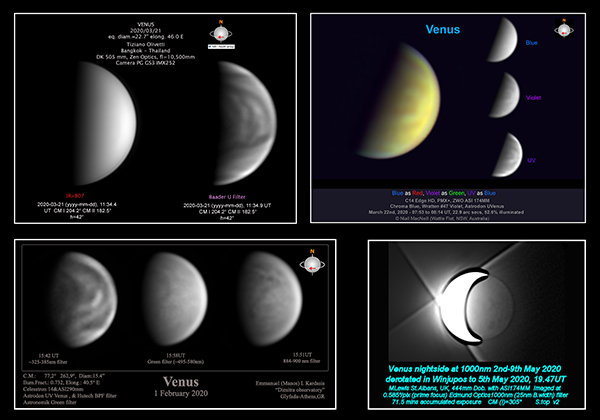
Observation windows
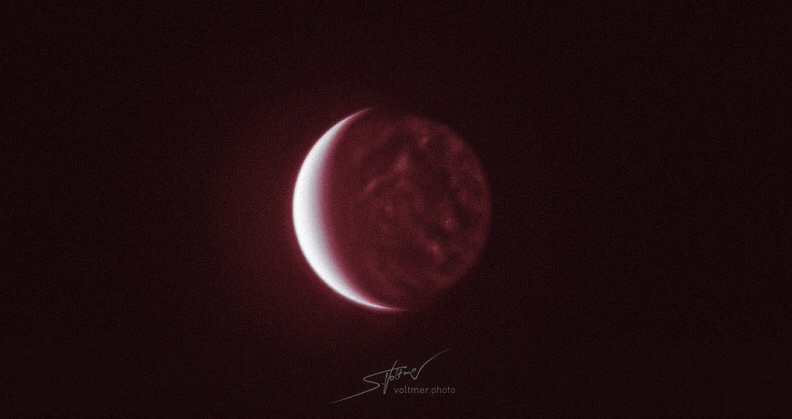
Date: July 1, 2020, Start time: 2:40 UT (duration 20 min), crescent start time: 03:17 UT
Telescope: Celestron 11 EdgeHD + Baader Fluorite Flatfield Converter (FFC)
Camera: Ninox 640 II SWIR camera from Raptor Photonics
Filter: Baader prototype Sloan-Z
Camera settings: Surface & nocturnal deeper clouds: 12.000 frames at 10 FPS, CCD temp. -31.7C + Dark Frame of 12.000 frames
Camera settings: Crescent: 12.000 short exp. frames, 30 FPS
Image credit: Dr. Sebastian Voltmer / www.astrofilm.com
How to participate
Highlights of these amateur observations will be posted in this webpage and in the
BepiColombo ESA page dedicated to the flyby.
![]()
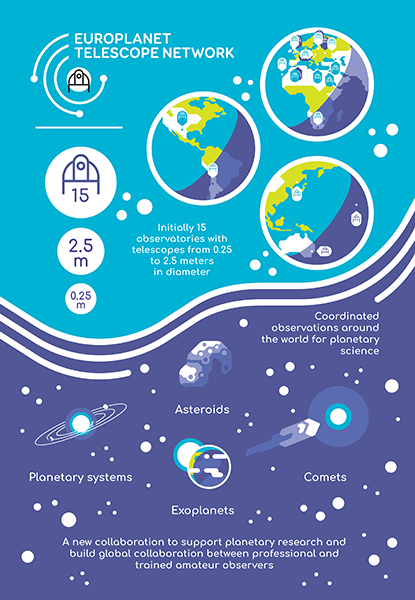
The Europlanet Telescope Network
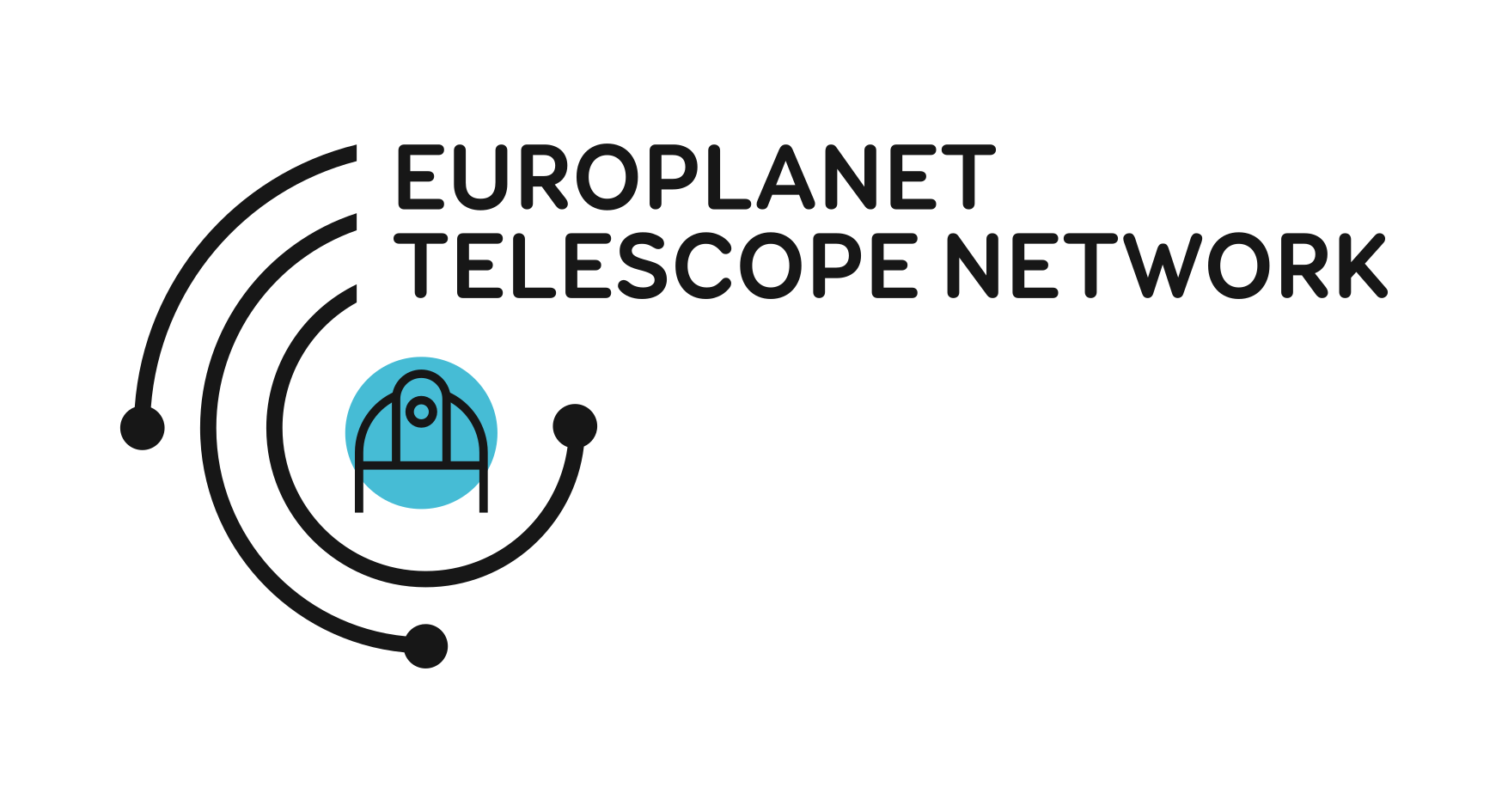
Time-line and desired observations

Additional information
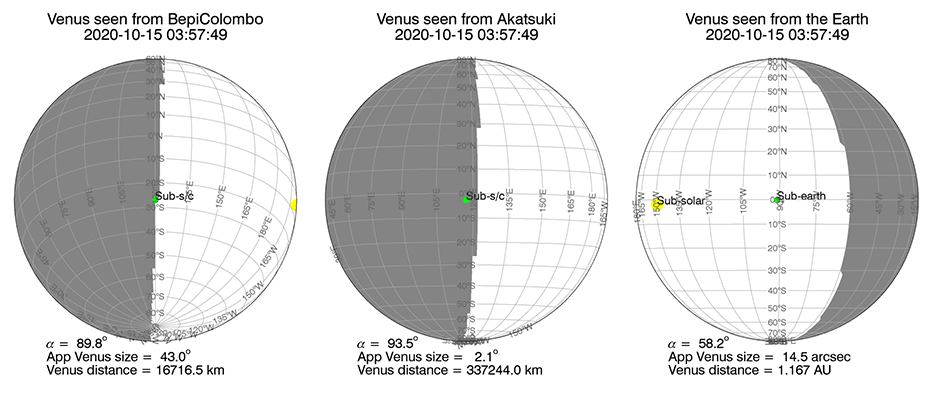 The figure in the right shows the coverage of Venus as observed from BepiColombo, Akatsuki and Earth on 15 October, 2020. The complementary views of different regions
of the atmosphere and surface from two spacecraft and Earth will provide a unique data set for Venus scientists. The different geometry of the illumination and viewing angle
are shown with the sub-solar point (yellow point in the figure) and the sub-spacecraft point (green).
Shaded regions correspond to local night at Venus and illuminated region to the day side.
Information about the second Venus flyby in August 10, 2021 will also be available here.
The figure in the right shows the coverage of Venus as observed from BepiColombo, Akatsuki and Earth on 15 October, 2020. The complementary views of different regions
of the atmosphere and surface from two spacecraft and Earth will provide a unique data set for Venus scientists. The different geometry of the illumination and viewing angle
are shown with the sub-solar point (yellow point in the figure) and the sub-spacecraft point (green).
Shaded regions correspond to local night at Venus and illuminated region to the day side.
Information about the second Venus flyby in August 10, 2021 will also be available here.
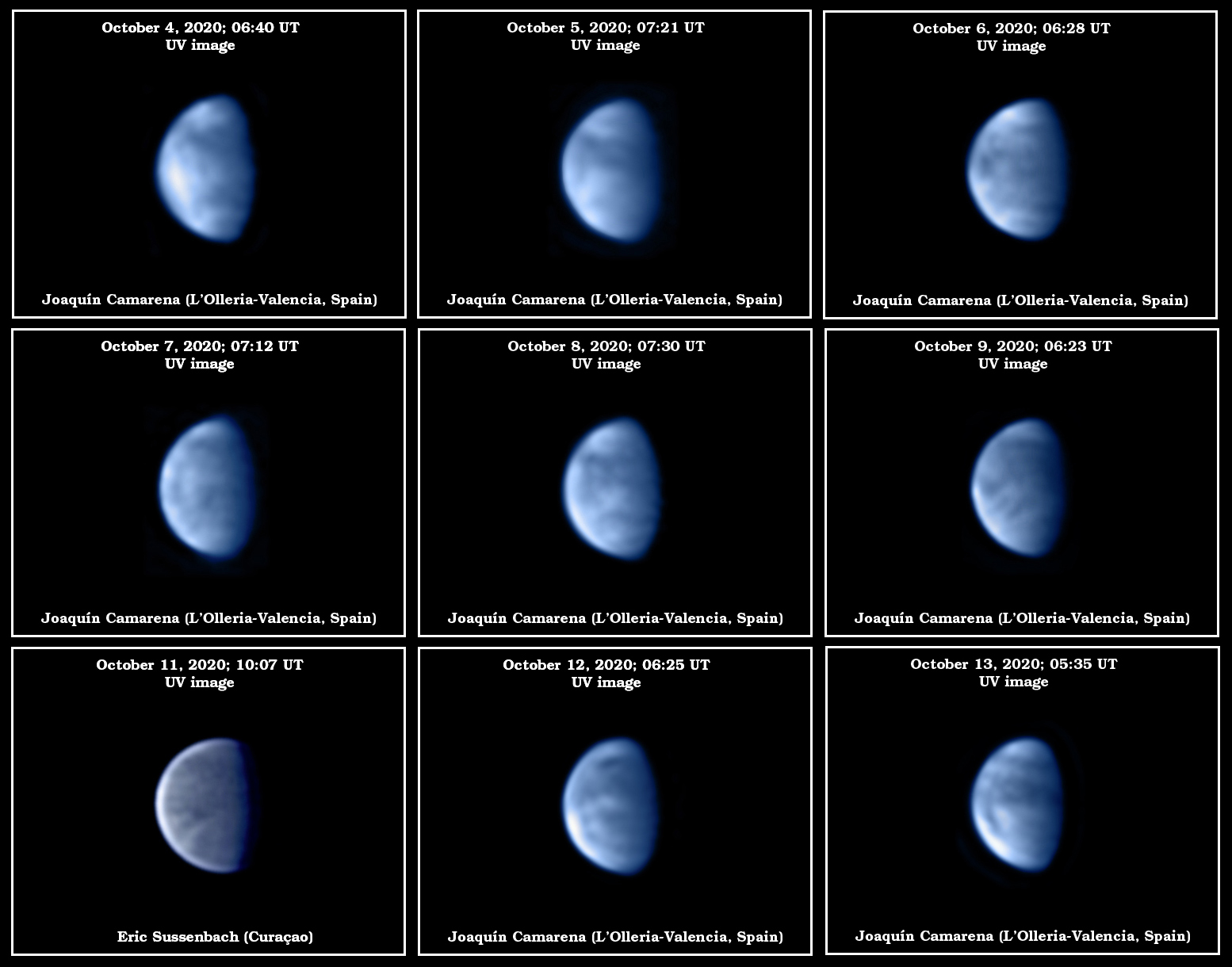
Amateur images close to the BepiColombo's 1st Venus Flyby
BepiColombo flybied Venus on 15 October at 03:58 UT as expected. Images released by ESA from the flyby were obtained by different cameras on the mission and show Venus as a distant object
viewed by the Mercury Transfer Module's Monitoring Camera 3,
or as a close planet as viewed by the Mercury Transfer Module's Monitoring Camera 2. The scientific images of the planet to be obtained by the spacecraft instruments are not yet available.
The images on the right show examples of representative observations obtained by amateur astronomers in the days before the flyby. These images were
obtained by Joaquin Camarena (Spain), Luigi Morrone (Italy), Emmanuel Kardasis (Greece) and Eric Sussenbach (Curacao).
The images show the evolution of Venus cloud tops in ultraviolet light and of the levels a few kilometers below observed in infrared light invisible to the human eye.
Additional images from other observers are available in PVOL and ALPO-Japan.
The goal of the campaign is to relate these ground-based observations with results from the instruments on the BepiColombo and Akatsuki spacecrafts.
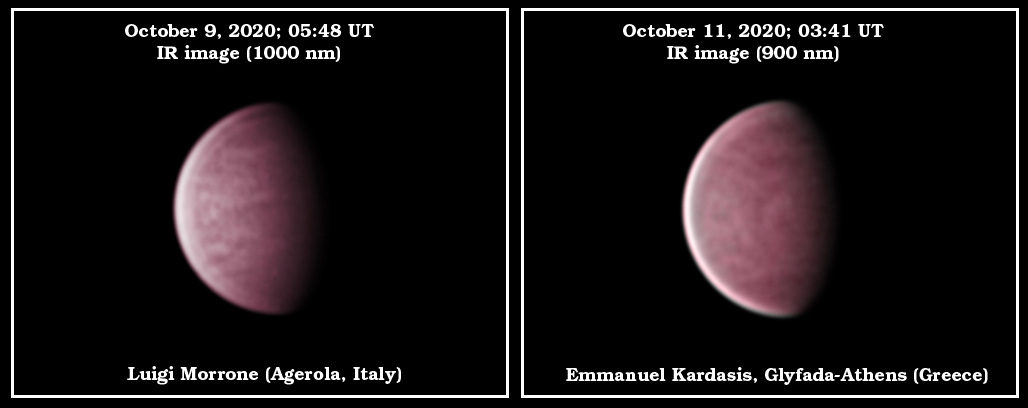
Further information on the BepiColombo's flyby
Acknowledgements
This campaign is supported by Europlanet 2024 RI.
Europlanet 2024 RI has received funding from the European Union's Horizon 2020
research and innovation programme under grant agreement No 871149.
We are very grateful to the ensemble of amateur astronomers sending their data to PVOL and participating in international observation campaigns.
Last updated: 15 October 2020.
Webpage hosted at the PVOL webserver at UPV/EHU